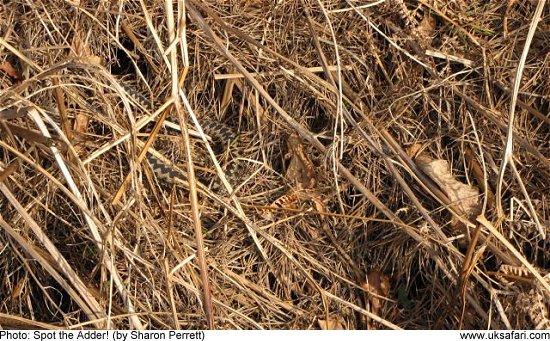The warmer daytime temperatures in March bring Adders (Vipera berus) out of hibernation. At this time of year they often sit motionless in the sunshine for long periods to warm up their bodies. This is an excellent time to observe them, but they're not always easy to see.
Adders are real masters of camouflage. You need to have your 'viper vision' in to notice them. If you didn't know there was at least one adder in the photo below would you have seen it? Honestly?

Adders tend to inhabit heathland and sand dunes. They often rest under logs and heaps of dead vegetation, but please don't go turning over logs looking for them. Adders don't like surprises! It's far better to wait for them to come out into the open. Early morning is the best time, when they're still cold from the previous night and they're only able to move at a slow pace. Once they get warmed up they can move surprisingly quickly.
If you're not sure where to start, try contacting your local reptile group for advice. Details in our links section.
Adders will only bite if they feel threatened, or if they're trodden on. Having said that, about 100 adder bites are reported in the UK each year. To avoid becoming one of those statistics, when you're in Adder territory simply watch where you put your feet (and hands). Tread lightly as they can sense vibrations.
A stout pair of leather boots or some equestrian leather half chaps are good insurance against accidents. Adders have good eyesight too, so move slowly and be careful not to let your shadow fall on them. Keep your eyes on the ground in front of you, and if you have a dog it's probably best to keep it on a lead, or at home.
If you're taking photographs, obviously be careful not to get too close. Adders can strike about half their body length... but you could get an extra energetic one. And never try to move an adder into a better position. Most of those 100 bites each year occur when people try to pick an adder up.
Related Pages
- UK Safari Adder Fact File
- Can I die from an adder bite?
- Adder Markings
- Black Adder Goes Forth
- UK Safari Reptile Section
 Adventures with Adders
Adventures with Adders



